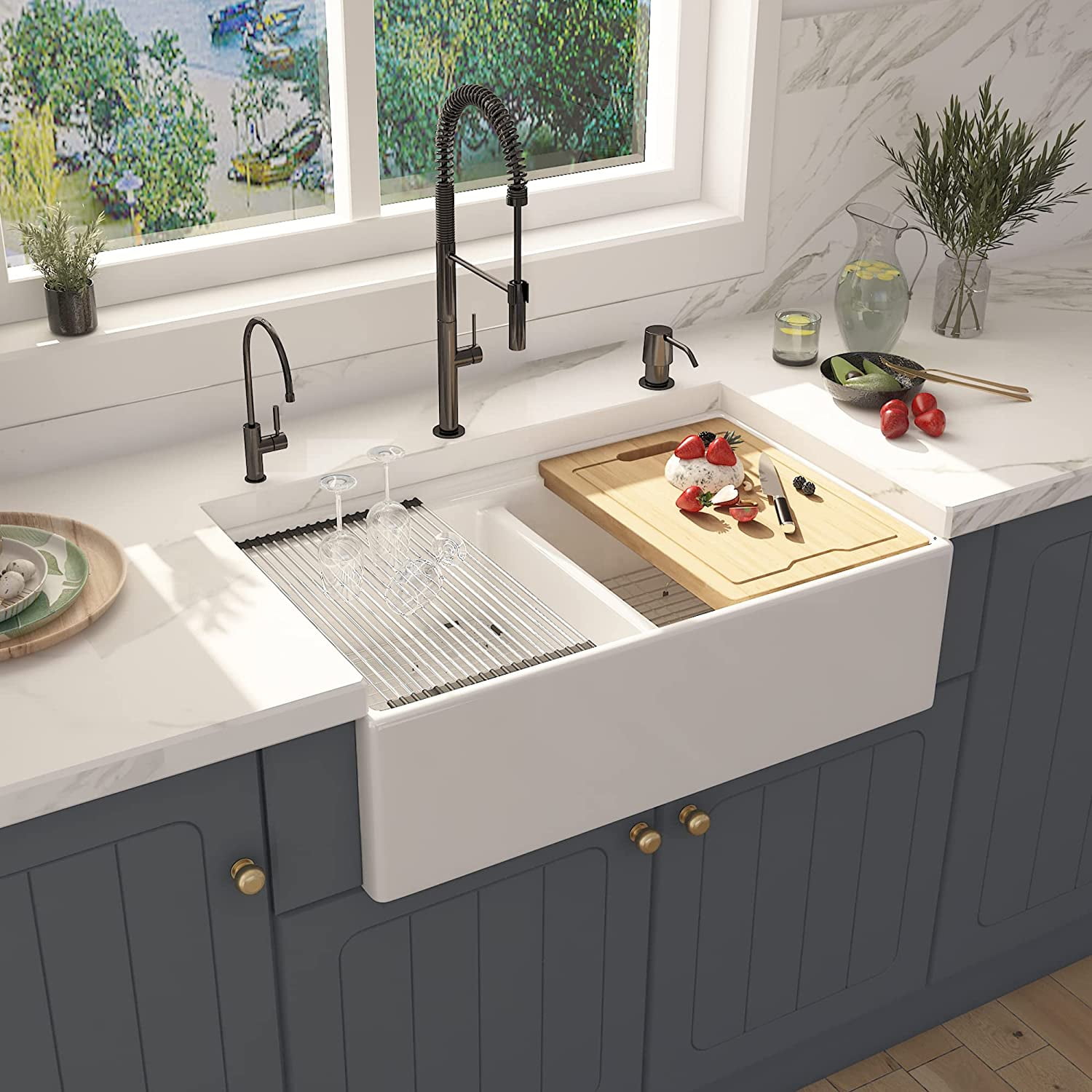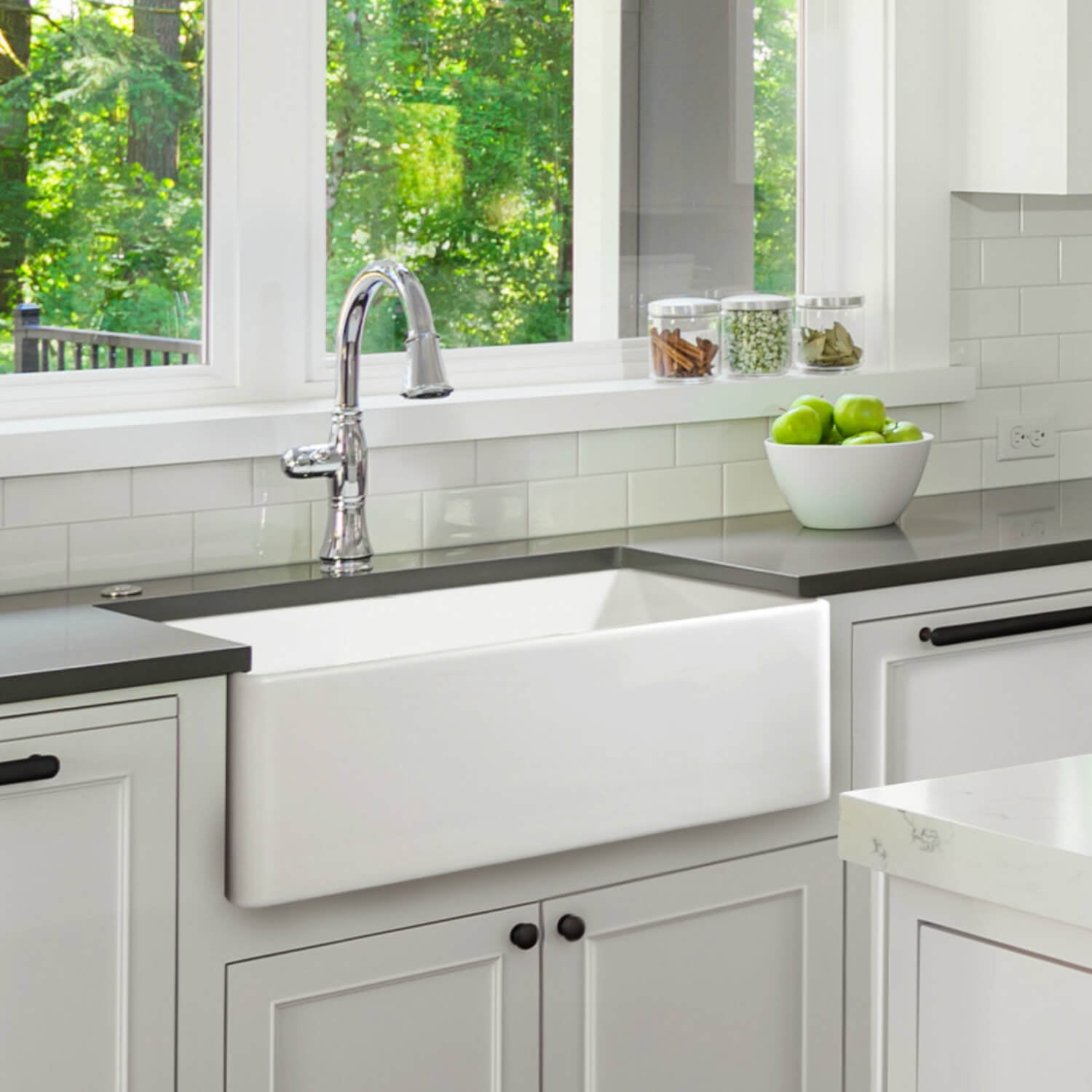Aesthetic Considerations of White Farmhouse Sinks and Cabinets

The enduring appeal of white farmhouse kitchens lies in their ability to create a space that is both timeless and inviting. The combination of white farmhouse sinks and white cabinets forms the cornerstone of this aesthetic, offering a clean, bright, and versatile backdrop for a variety of design choices. Careful consideration of sink styles, cabinet designs, and countertop materials is crucial in achieving the desired look and feel.
White Farmhouse Sink Styles and Materials
The term “farmhouse sink” encompasses a range of styles, each with unique characteristics impacting the overall kitchen aesthetic. Choosing the right sink depends on factors such as available space, desired functionality, and personal style preferences. Material selection also plays a significant role in durability and maintenance.
| Style | Material | Pros | Cons |
|---|---|---|---|
| Apron-Front | Fireclay, Cast Iron, Stainless Steel | Adds a dramatic focal point; durable and long-lasting; available in various colors and finishes. | Can be heavy; fireclay can chip; requires specific installation. |
| Farm Style (Apron-less) | Stainless Steel, Composite Granite | More versatile installation; lighter weight than apron-front; often less expensive. | Less visually striking than apron-front; may show scratches more easily (stainless steel). |
| Undermount | Stainless Steel | Clean lines; easy to clean; seamless integration with countertop. | Requires precise installation; less forgiving of uneven countertops. |
| Drop-in | Stainless Steel, Composite Granite | Easy installation; cost-effective; widely available. | Can appear less integrated with the countertop; may show a visible rim. |
Cabinet Styles Complementing White Farmhouse Sinks
Cabinetry choices significantly influence the overall style and feel of a farmhouse kitchen. The interplay between cabinet design and sink selection creates a cohesive and visually appealing space. Several cabinet styles pair well with white farmhouse sinks, offering diverse options to suit various preferences.
White farmhouse sink with white cabinets – Shaker-style cabinets, with their simple, clean lines and recessed panel doors, provide a classic and versatile backdrop for a white farmhouse sink. These cabinets are often constructed from solid wood such as oak or maple, and can be painted in various shades of white, from crisp bright white to creamy off-whites. Hardware choices range from simple knobs to more ornate pulls, allowing for customization.
Alternatively, slab-door cabinets offer a more modern and minimalist approach. Their flat, unadorned fronts create a sleek and contemporary look that can complement a farmhouse sink’s rustic charm, providing a balanced aesthetic. These cabinets can be made from various materials, including painted wood or even high-gloss lacquered finishes. Handleless designs or minimalist bar pulls are frequently chosen for this style.
Countertop Materials and Visual Impact
The countertop material chosen significantly impacts the overall aesthetic of a white farmhouse kitchen. Different materials offer unique visual and functional characteristics, influencing the overall design harmony.
- Granite: Granite countertops offer a luxurious and durable option. Their natural veining and color variations can add visual interest and warmth to a kitchen featuring white farmhouse sinks and cabinets. Popular choices include white or light-colored granites with subtle veining to complement the clean aesthetic.
- Quartz: Quartz countertops offer a non-porous and highly durable surface that is easy to maintain. Their consistent color and pattern provide a sleek and modern look, complementing both traditional and contemporary styles. White or light-colored quartz options create a cohesive and bright look with white farmhouse sinks and cabinets.
- Butcher Block: Butcher block countertops offer a rustic and warm aesthetic, adding a touch of natural beauty to the kitchen. The rich wood grain contrasts beautifully with the clean lines of a white farmhouse sink and cabinets, creating a balanced and inviting atmosphere. However, butcher block requires regular maintenance and oiling to preserve its appearance and durability.
Practical Aspects and Functionality

The allure of a white farmhouse sink paired with crisp white cabinets is undeniable, but a discerning homeowner must also consider the practical implications of this aesthetically pleasing combination. This section delves into the maintenance, durability, sizing options, and installation challenges associated with this popular kitchen design choice. Understanding these aspects is crucial for ensuring both long-term satisfaction and functionality.
Maintenance and Durability of White Farmhouse Sinks
White farmhouse sinks, typically crafted from materials like porcelain, fireclay, or composite granite, present a unique set of maintenance considerations. While their bright aesthetic enhances kitchen ambiance, their light color makes stains and scratches more visible than darker counterparts. Porcelain and fireclay, known for their durability and resistance to chipping, require regular cleaning to prevent discoloration from acidic foods or hard water deposits. Composite granite sinks, while stain-resistant, can be susceptible to etching from abrasive cleaners. Effective cleaning involves using mild detergents and avoiding abrasive scouring pads. Prompt attention to spills is crucial to prevent staining. Regular application of a sealant can enhance the longevity and stain resistance of certain materials. For persistent stains, specialized cleaning agents designed for the specific sink material should be used, following manufacturer instructions meticulously.
Sink Sizes and Depths: Suitability for Various Kitchen Layouts
The dimensions of a farmhouse sink significantly impact its functionality within a given kitchen space. A larger, deeper sink offers ample room for washing bulky items, while a smaller, shallower one might be better suited for smaller kitchens or families with less demanding needs. The following table summarizes the pros and cons of various size and depth combinations:
| Size | Depth | Pros | Cons |
|---|---|---|---|
| Small (e.g., 24 inches) | Shallow (e.g., 8 inches) | Space-saving, suitable for small kitchens, easy to clean | Limited capacity, may not accommodate large pots and pans |
| Medium (e.g., 30-33 inches) | Medium (e.g., 9-10 inches) | Versatile size, accommodates most kitchen tasks, good balance of capacity and space | May require more counter space for comfortable use |
| Large (e.g., 36 inches or more) | Deep (e.g., 10 inches or more) | Excellent capacity, ideal for large families or those who frequently wash bulky items, accommodates multiple dishes simultaneously | Requires significant counter space, may be challenging to clean the bottom |
Installation Challenges and Plumbing Considerations
Proper installation of a farmhouse sink is crucial for both its functionality and longevity. The process can present several challenges, particularly regarding plumbing and cabinet modifications. A common issue involves ensuring adequate clearance for the sink’s apron front, which might require adjustments to existing cabinetry. Plumbing connections must be carefully planned and executed to avoid leaks and ensure proper drainage. The weight of a farmhouse sink necessitates robust support from the underlying cabinetry; insufficient support can lead to structural issues. Furthermore, the sink’s apron front might necessitate specific cutout dimensions in the countertop, requiring precision during installation. Consulting with a professional plumber and experienced installer is strongly advised to mitigate these potential challenges and ensure a seamless and trouble-free installation.
Design and Inspiration: White Farmhouse Sink With White Cabinets

The enduring appeal of white farmhouse sinks and cabinets lies in their versatility. They serve as a blank canvas, readily adaptable to a spectrum of kitchen styles, from the rustic charm of a traditional farmhouse to the sleek minimalism of a modern interpretation. The key to success lies in thoughtfully selecting complementary elements – flooring, backsplash, lighting, and accessories – to create a cohesive and visually stunning space.
A well-designed kitchen featuring white farmhouse sinks and cabinets transcends mere functionality; it becomes a statement of personal style and a reflection of the homeowner’s aesthetic sensibilities. This section explores several design concepts, highlighting the interplay of various elements to achieve distinct looks and feels.
Modern Farmhouse Kitchen Design
This concept blends the clean lines and minimalist aesthetic of modern design with the warmth and rustic charm of a farmhouse. Imagine a kitchen with crisp white shaker-style cabinets, paired with a pristine white farmhouse sink. The flooring could be wide-plank light oak, offering a natural contrast to the bright white. A subtle, textured backsplash, perhaps a creamy white subway tile with a slightly irregular finish, adds visual interest without overwhelming the space. Recessed lighting provides ample illumination, while a statement pendant light above the island adds a touch of drama. The overall feeling is one of airy spaciousness, infused with a sense of relaxed sophistication.
Rustic Farmhouse Kitchen Design, White farmhouse sink with white cabinets
In contrast to the modern farmhouse approach, a rustic farmhouse kitchen embraces a more lived-in, textured aesthetic. White cabinets, perhaps with a slightly distressed finish, create a sense of age and character. The white farmhouse sink remains the centerpiece, complemented by a dark wood floor, such as reclaimed barn wood, providing a grounding element. A backsplash of natural stone, like tumbled limestone or a rustic brick, further enhances the rustic feel. Warm, ambient lighting from wrought iron sconces and a large, farmhouse-style chandelier creates a cozy and inviting atmosphere. The overall impression is one of comfortable, unpretentious elegance.
Accessory and Decorative Element Integration
The choice of accessories and decorative elements plays a crucial role in defining the overall aesthetic of a kitchen featuring white farmhouse sinks and cabinets. Careful selection can elevate the space from functional to truly exceptional.
The following points illustrate how different choices can significantly alter the overall design:
- Faucet Styles: A sleek, modern gooseneck faucet provides a stylish contrast to the traditional sink, while a more ornate, vintage-style faucet enhances the rustic charm. Consider a brushed nickel or oil-rubbed bronze finish for a touch of warmth against the white.
- Soap Dispensers: A ceramic soap dispenser with a simple, elegant design complements a modern farmhouse style, while a rustic, metal dispenser fits seamlessly into a more traditional setting. Choose a dispenser that matches the overall color palette and material choices.
- Dish Racks: A minimalist, stainless steel dish rack provides a clean, modern look, whereas a wooden dish rack adds a touch of rustic charm. The choice should align with the overall style of the kitchen.
